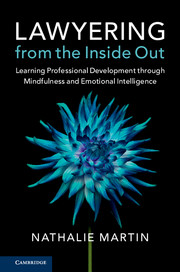 Lawyering from the Inside Out
Lawyering from the Inside Out from PART I - NURTURING YOUR BEST SELF
Published online by Cambridge University Press: 18 May 2018
This chapter asks you to examine your personal role in the profession through the lens of society's perceptions of attorneys. We ask that you place a vivid image of yourself as a lawyer front and center in your mind, and then read about lawyer jokes and images of lawyers in books, television, and movies. We then return to your own view of yourself to think about your professional identity formation in the law. We study themedia and the jokes to see how we can work together to dispel negative images of our profession. As you no doubt know, lawyer jokes and negative images in the media are incredibly prevalent. Indeed, when hearing that we are writing a book about mindful lawyering, many people assume it is a joke about an oxymoron.
Lawyer jokes and media images of lawyers may not be totally accurate, but they do provide a window into the public's perception of our profession.While these jokes and television and movie roles may be funny or entertaining on some level, they portray lawyers in a way that perpetuates deeply negative stereotypes. Many of these jokes also have an ounce of truth in them. As a profession, we need to look at ourselves, our training, and our practices to see what can be done to change not only our collective image, but our actions. The goal of this chapter is to lead you on the path toward creating this necessary change in the profession. In this chapter, we examine the roles of lawyers in society from the perception of the general public, so you can imagine and find your place in that world. First, however, we ask you to visualize yourself as a lawyer.
YOUR PLACE IN THE LAW
Your Image of Yourself
LAW PAUSE
Think about what people said when you told them you were going to become a lawyer. Write a few sentences about the themes of these reactions.
Little Pause: Think of your favorite positive image of a lawyer in society. Now think of a negative one. Muse for a moment about where these images come from.
To save this book to your Kindle, first ensure no-reply@cambridge.org is added to your Approved Personal Document E-mail List under your Personal Document Settings on the Manage Your Content and Devices page of your Amazon account. Then enter the ‘name’ part of your Kindle email address below. Find out more about saving to your Kindle.
Note you can select to save to either the @free.kindle.com or @kindle.com variations. ‘@free.kindle.com’ emails are free but can only be saved to your device when it is connected to wi-fi. ‘@kindle.com’ emails can be delivered even when you are not connected to wi-fi, but note that service fees apply.
Find out more about the Kindle Personal Document Service.
To save content items to your account, please confirm that you agree to abide by our usage policies. If this is the first time you use this feature, you will be asked to authorise Cambridge Core to connect with your account. Find out more about saving content to Dropbox.
To save content items to your account, please confirm that you agree to abide by our usage policies. If this is the first time you use this feature, you will be asked to authorise Cambridge Core to connect with your account. Find out more about saving content to Google Drive.